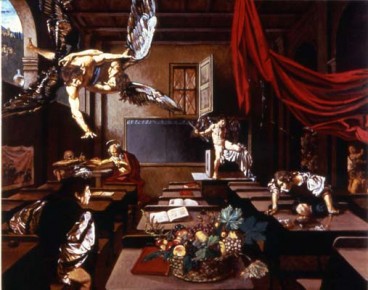Related Works
|
| WorkSchool of Caravaggio
| Image Notes
As the allegorical work School of Caravaggio, 1984, by George Deem suggests, neatness, purity, and perfect painting can only lead to excess, an excess that transforms a representation of excess into an excess of representation, a baroque realism into a postmodern culture of simulacrum, a baroque historicism into a postmodern metahistory. This image is baroque not just in what it refers to but in its querying of period delimitation, in its combative historicism.
(This painting) fragments Caravaggio's work into bits of representation, which are in turn isolated, enshrined, into individual masterpieces, yet related through spatial, erotic, and hostile emulations. Thus, the background, the old Saint Jerome on the left, mirrors what is perhaps the most attractive young male body in the history of Western painting. From close to the picture plane on the (left), diagonally across the room to the child who has witnessed Saint Matthew's martyrdom, a more promising exchange is going on. But the most unsettling students in this school are in the middle ground: the pair of wrestlers in the air. Quoting various struggles between heavenly and earthly Amors, their ambiguous status between sculpture and painting, between inside and outside, between war and love, may well be what the elegant Narcissus sees when he mirrors himself to death. The preposterous history proposed here is not simply a postmodern act of quoting the past. It is from the historical Baroque -- but recycled for today -- that this principle of quotation is quoted in the first place. If taken not as an academic but as an anthropological case, the attempts to enshrine the "Baroque" as a historically delimited period must be seen, in addition, as a violent oppression that turns mirrors out of balance and knocks over chairs, or worse (George Deem, Italian Vermeer (Caravaggio), 1977). Attempts to make it universal, alternating with Classicism or not, just because "it happens" again today, are equally violent, suppressing the fact that we, too, are in history. (Mieke Bal,Quoting Caravaggio: Contemporary Art, Preposterous History, The University of Chicago Press, 1999. 266, 267.) | ExhibitionsFlint Institute of Arts, Flint, Michigan
Evansville Museum of Arts and Science, Evansville, Indiana Indiana State Museum, Indianapolis, Indiana |
| WorkSchool of Caravaggio
| Image Notes| Exhibitions |

